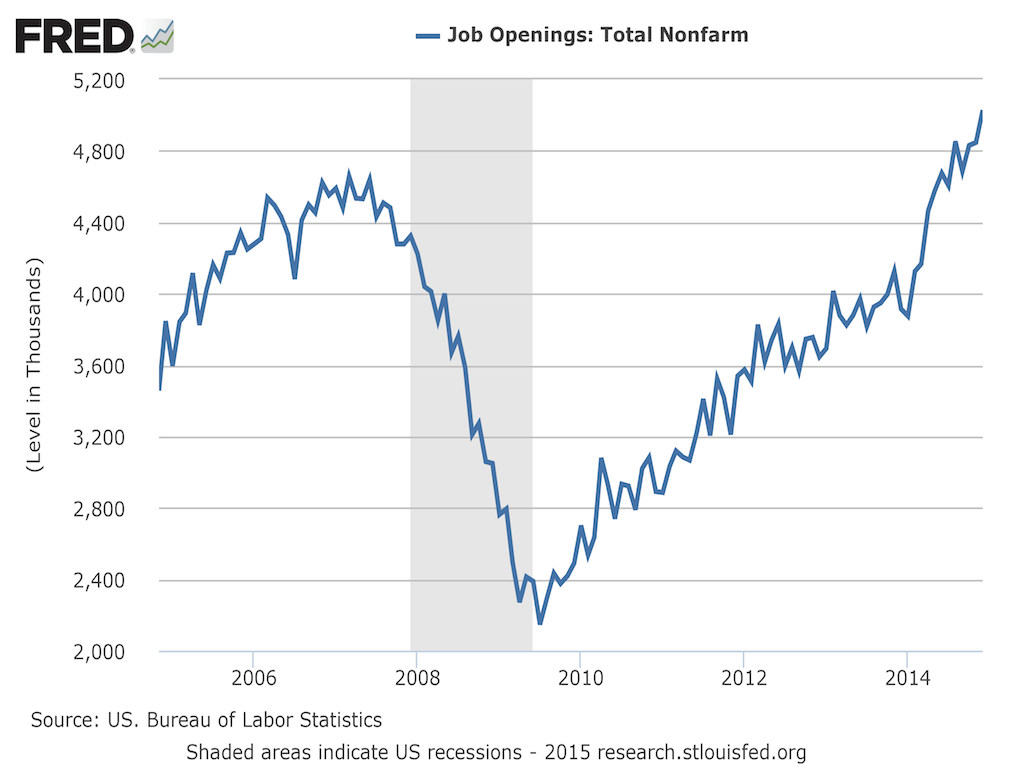CHART OF THE DAY: There's Just 5 Million Open Jobs in the USA
Here's your latest Chart of the Day, courtesy of my two favorite online data sources, the Bureau of Labor Statistics, (specifically the Job Openings and Labor Turnover Summary, or JOLTS report), and the FRED data analysis and visualization tool.
First, the chart, then some FREE commentary from your humble scribe:

1. First, the actual numbers - there were 5.028 million job openings in the US on the last business day of December 2014, the highest number since December 2001.
2. The chart shows a pretty much straight up and to the right climb in job openings since early 2009, meaning talk of the recession and the labor market disruptions it caused are really seeming far, far behind us
3. This increase in openings is driving organizations like Walmart to raise wages for many of its workers - for a wide range of industries, and geographies, (including previously 'low worker power' ones like retail), the balance of that power is shifting.
4. Average weekly earnings for Production and Non-farm employees are climbing as well, not as fast as jop openings, but certainly on the same trajectory.
So what does this mean for you, Mr. or Ms. HR pro?
Probably nothing new, or at least nothing you have not been hearing about and likely experiencing in the last 18 months or so.
Lots more noise in the system to get your company and your opportunities noticed in a much more crowded market of available jobs.
Many fewer un- and under-employed individuals around that might not always been qualified for your openings, but at least were a source of steady candidate flow. At the depths of the recession, there were about 7 unemployed workers for every job opening. Today that ratio is less than 2/1.
You, having a harder time coming up with explanations/excuses to your leadership and hiring managers who (traditionally) are much slower to accept these changes in the labor market and the ensuing power shifts. I recommend forwarding to them the Walmart story above, with a subject line that says 'See, even Walmart is having a hard time finding and keeping people'.
Long story short, we entering year 6 of an extended recovery/tightening of the labor market. Talent is in shorter supply, opportunities are everywhere, the Dow and the S&P 500 are at record highs, and the people you need to find, attract, and retain are well, harder to find, attract, and retain.
Have fun, it's a jungle out there.

 Steve
Steve
Reader Comments (3)
Hello,
Thank you for this insightful (yet slightly disheartening) post. HR professionals in all geos and in all industries seem to be having a hard time finding top talent, or even hanging on to the employees they have. Enticing employees to come on board (or to stay) required a bigger budget, which is something many companies do not have. To make the entire human resources job a bit easier, companies can lean on HR software to streamline processes, cut costs, and boil down to the bottom line. Thanks for giving us this information to prove this is an overarching issue. While it’s not easy for everyone to see, it is kind of hard to deny when it’s in black and white.
All the best,
Lauren
You must check out these posts too!!
get a job tips
How to find a job in India
tips to help on getting a job
We can see other topics here fnaf 1